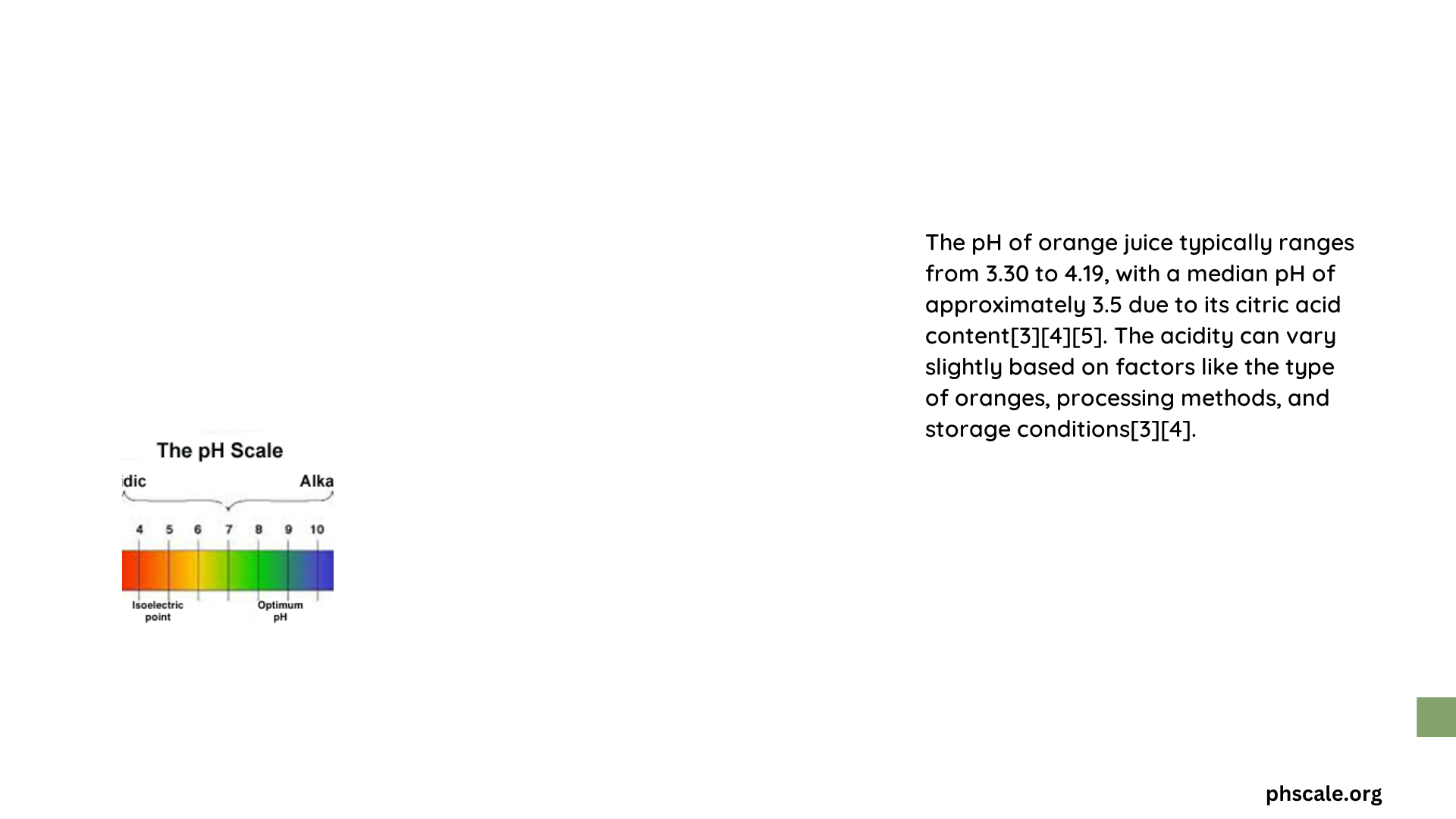Orange juice pH science involves the study of acidity levels in citrus juices, their impact on flavor, and measurement techniques. The pH of orange juice typically ranges from 3.30 to 4.19, depending on factors like orange variety and growing conditions. This acidity plays a crucial role in the taste, quality, and preservation of orange juice. Understanding pH in orange juice science helps in quality control, flavor optimization, and ensuring food safety standards.
What Are the Typical pH Levels in Fresh Orange Juice?
Fresh orange juice exhibits a range of pH levels, primarily due to variations in orange varieties and growing conditions:
- California Orange Juice: pH 3.30-4.19
- Florida Orange Juice: pH 3.30-4.15
- Florida Whole Oranges: pH 3.69-4.34 (juice from whole fruit)
These variations stem from differences in:
- Specific orange varieties
- Growing conditions
- Processing methods
How Does Pulp Content Affect Orange Juice pH?

The presence or absence of pulp in orange juice does not significantly impact its pH level:
- Both no-pulp and fresh-squeezed orange juices typically fall within the same pH ranges mentioned above.
- No substantial pH difference is observed between pulp and no-pulp varieties.
However, pulp can influence other aspects of the juice:
- Flavor profile: Pulp may add a slightly bitter taste
- Texture: Pulp creates a more textured mouthfeel
- Perceived sweetness: No-pulp juice might taste slightly sweeter due to the absence of bitter compounds from pulp
What Impact Does pH Have on Orange Juice Flavor?
The pH level of orange juice significantly influences its flavor profile and overall quality:
- Acidity and Taste Perception:
- Lower pH (higher acidity) = Sharper, more sour taste
- pH closer to 3.30 = More acidic and refreshing
-
pH closer to 4.19 = Milder and less acidic
-
Flavor Profile:
- Acidity balances sweetness
- Higher acidity enhances perception of sweetness and other flavor compounds
-
Result: More vibrant and refreshing taste
-
Overall Quality:
- Optimal pH range: 3.5 to 4.0
- Best balance of acidity and sweetness
- More palatable to consumers
How Can Orange Juice pH Be Accurately Measured?
Accurate pH measurement of orange juice involves several key steps and considerations:
Equipment
- pH meters (recommended for precision)
- pH test strips (preferably 3-pad for better accuracy)
Calibration
- Use standard buffer solutions (e.g., pH 4.0 and pH 7.0)
- Calibrate pH meter or test strips before measurement
Sample Preparation
- Ensure orange juice is at room temperature or specified temperature (e.g., 25°C or 6°C)
- Avoid contamination
- Mix sample well before testing
Potential Challenges
- Temperature variations can affect pH readings
- pH test strips may be less precise than pH meters, especially for close pH values
What Factors Influence pH Levels in Orange Juice?
Several factors can impact the pH levels in orange juice:
- Orange Variety:
- Different orange cultivars have varying acid content
-
Example: Valencia oranges tend to be more acidic than Navel oranges
-
Ripeness:
- As oranges ripen, their acidity generally decreases
-
Overripe oranges may have higher pH (less acidic) juice
-
Growing Conditions:
- Soil composition
- Climate
-
Irrigation practices
-
Processing Methods:
- Fresh-squeezed vs. commercially processed juice
-
Pasteurization can slightly affect pH
-
Storage Conditions:
- Temperature
- Duration of storage
- Exposure to air
How Does pH Affect Orange Juice Preservation?
The pH level of orange juice plays a crucial role in its preservation:
- Microbial Growth:
- Low pH (high acidity) inhibits growth of many harmful bacteria
-
Most pathogenic bacteria cannot survive below pH 4.6
-
Enzyme Activity:
-
Low pH slows down enzymatic reactions that can cause spoilage
-
Vitamin C Retention:
-
Acidic environment helps preserve vitamin C content
-
Shelf Life:
- Lower pH generally contributes to longer shelf life
| pH Range | Preservation Effect |
|---|---|
| < 3.5 | Excellent preservation, longer shelf life |
| 3.5 – 4.0 | Good preservation, standard shelf life |
| > 4.0 | Reduced preservation, shorter shelf life |
What Role Does pH Play in Orange Juice Quality Control?
pH measurement is a critical aspect of quality control in orange juice production:
- Consistency:
- Ensures consistent flavor profile across batches
-
Helps maintain brand standards
-
Safety:
- Verifies that pH is low enough to prevent pathogen growth
-
Critical for food safety regulations
-
Flavor Optimization:
- Allows producers to adjust acidity for optimal taste
-
Helps balance sweetness and tartness
-
Processing Decisions:
- Influences pasteurization parameters
-
Guides decisions on additives or blending
-
Shelf Life Prediction:
- Helps estimate product stability and shelf life
By understanding and controlling pH, orange juice producers can ensure a high-quality, safe, and consistent product that meets consumer expectations and regulatory standards.
